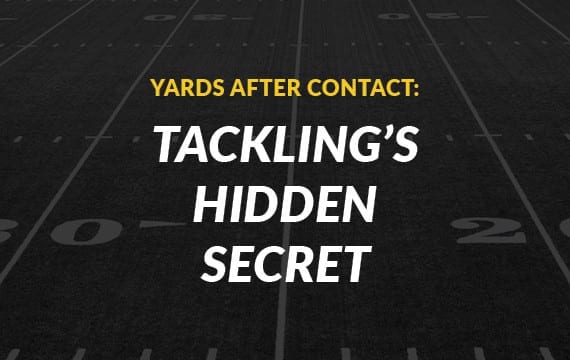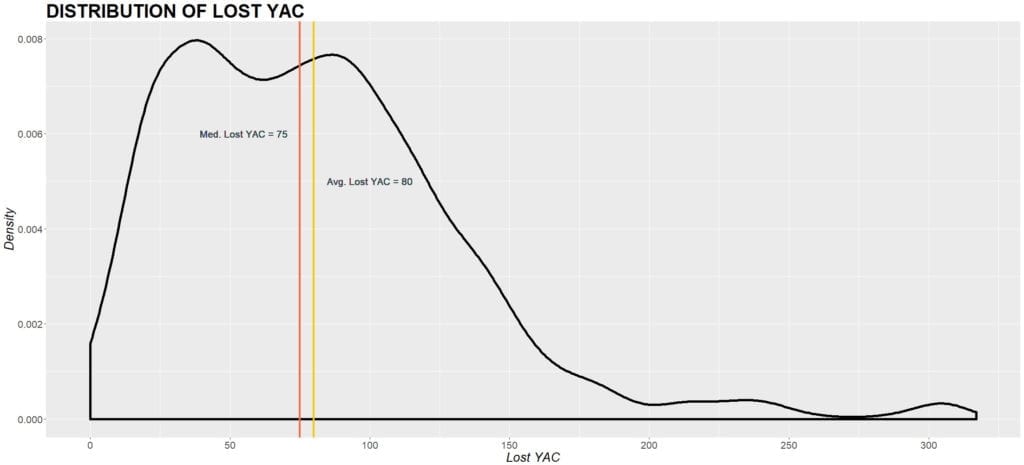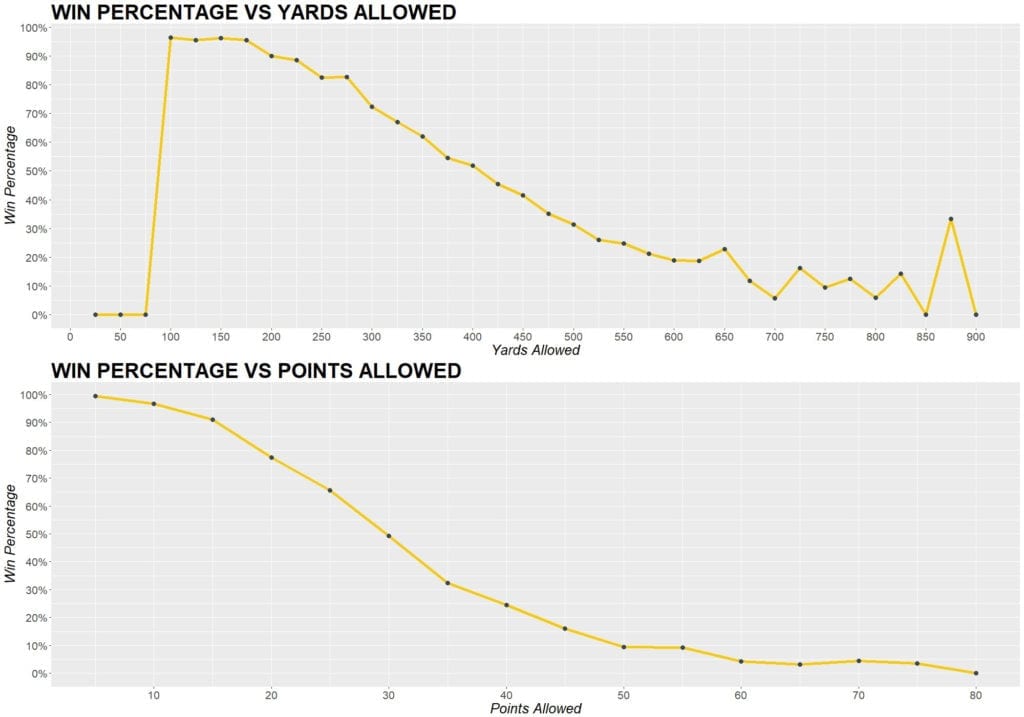| Yards after contact are typically considered an offensive stat, but at Atavus we believe they are critical to understanding defensive performance. |

Adam Minthorne, Feb. 27th 2019
Highlights:
Defensive players and coaches will tell you that if you can’t tackle then you will spend more time on the sideline than you will on a field. Even most fans will recognize that if a team is tackling poorly the opposition will likely score more points. Tackling is fundamental to defense, but how much can a team improve their defensive performance by improving tackling performance?
Atavus analyzes game data to develop and improve the tackling technique, and ultimately the defensive performance, of our clients. One of the key performance metrics we track is defensive yards after contact (YAC).
Yards after contact is a familiar statistic on the offensive side of the ball, but here at Atavus we believe—based on data—that understanding how many yards after contact your tacklers are allowing can be incredibly important in understanding defensive performance. Players and teams who tackle effectively minimize the number of YAC over the course of the game and the course of the season.
The Atavus Approach: Situation
While teams want to reduce YAC, expecting 0 YAC on every tackle is unrealistic. Tackles are made in a variety of ways, by chasing down a ball carrier from behind, or, for example, by diving laterally where the momentum of a ball carrier drags the tackler down the field. These are tackles where one or two YAC could occur regardless of the tackler’s technique. For this reason, we track the situation of every tackle. At Atavus, we define the relationship between the tackler, ball carrier, and the line of scrimmage as the Situation.
All other situations are considered negative situations because the tackler is at a disadvantage with respect to YACs.

Figure 1: Atavus Tackle Wheel demonstrating positive and negative situations.
The situation of a tackle plays a critical role in determining whether a tackle is effective. In positive situations a tackle is effective if a tackler allows 1 YAC or less. This is because the tackler is in the advantageous position to knock the runner backwards and give up 0 YAC. Tackles in negative situations are effective if a tackler allows 2 YAC or less to reflect the disadvantaged position of the tackler. In the data set we examined for this analysis, 65% of tackles in positive situations were effective; 58% of tackles in negative situations were effective. This serves as a benchmark for effective tackling teams. For the purpose of this analysis and blog post, a team that yields 1 YAC or less in positive situations more than 65% of the time—and 58% of negative situations allowing 2 YAC or less—is considered an effective tackling team.
Lost YAC
The question, then, is how many yards could be saved by being a more effective tackling team and whether those saved yards improve the chances of winning games.In the past three years, Atavus has evaluated more than 55,000 tackles. For the purpose of this analysis, we’re going to look at 7,000 tackles from eight seasons over two years from FBS and FCS teams. Using this data, we simulated thousands of games and examined YAC allowed. Figure 2 shows the distribution of Lost YAC that we saw in those simulations. (Note that our marketing guy wouldn’t let me put an in-depth accounting of my methodology in the middle of the blog post, so if you’re interested in the nitty gritty of how we did it, please see below.)

Figure 2 shows the distribution of Lost YAC from each of simulated games.
Fewer Lost YAC = More Wins
So there it is: an average college team can save 75 yards after contact with better tackling.
To put this number into context, we looked at data from every NCAA D1 college football game between the years 2011 and 2018.to understand the relationship between points allowed, yards allowed, and win percentage. This relationship is examined in Figure 3.

Figure 3: Relationship between, points allowed, yards allowed, and result.
There is clearly a relationship between yards, points, and wins, even if it isn’t as clean as we might have expected. For example, if a defense allowed 250 yards it is possible that they lost and gave up 45 points or that they won and only gave up 3 points. This makes sense because special teams, offensive performance, and opposing defensive scores could affect the point total while not affecting the yards allowed by a defense. However, generally we can see that more yards allowed means more points on average.
In fact, our analysis suggest that, on average, 11 yards allowed is equivalent on one point scored by the other team. Thus, reducing YAC by 66 yards in equivalent to a touchdown.
In Figure 3, wins and losses are color coded, but it is difficult to see how exactly yards and points effect win percentage. Figure 4 shows the relationship between win percentage and both yards and points allowed by binning intervals of yards into 25-yard intervals and points into 5-point intervals. (The jump in win percentage around 875 yards reflects that only 3 games reached that many yards allowed, one of which was won by a very lucky defense).

Figure 4:
Left: Relationship between win percentage and yards allowed.
Right: Relationship between win percentage and points allowed.
Taking a closer look at Win Percentage vs Yards allowed in Figure 5, 75 saved yards can go a long way in terms of winning percentage. Figure 6 zooms in on Figure 5, highlighting that a team allowing 400 yards has a slightly-better-than a coin’s toss chance to win the game, whereas allowing 325 improves the odds to 67%--a massive difference. That’s the difference between 6-5 and 8-3.

Figure 5: A closer look at win percentage and yards allowed, scaled to look at the interval between 250 and 450 yards. Highlighted triangles demonstrate how a reduction of 75 YAC can improve winning percentage.
Whether you think 75 yards sounds like a lot or not, these hidden yards can have a profound impact on winning and losing games. We have more to learn about the impact of hidden yards, but it is clear that preventing YAC through more effective tackling will improve your team’s chances to win.
Appendix: Methodology
The following explanation is meant for those who want a deeper understand of our approach to the analysis.
Using data from 7,000 tackles, we built a model using multinomial distributions to simulate each game under ideal tackling conditions. The key assumption is that each simulation assumes that teams perform in the 100th percentile of tackling with respect to tackling situation. Each simulation produces a simulated YAC total from the game, which represents the YAC a team allows tackling at achievable tackling performance. Subtracting the true YAC from the simulated YAC gives us the YAC lost to ineffective tackling in a game. Since lost YAC isolates the yards that defense allows during tackling, we can infer that if a team tackles to the best of their ability, their total yards should be reduced by lost YAC from a game.
We simulated 87 games 100 times each (due to computational constraints) for a total of 8,700 lost YAC calculations. Examining the distribution of lost YAC, we find that the average lost YAC is 80 yards per game and the median lost YAC is 75 yards per game. Due to the large tail on the distribution, the median of 75 lost YAC is the best representation of yards prevented due to increased tackling performance.
For more on methods: email adam.hinthorne@atavus.com